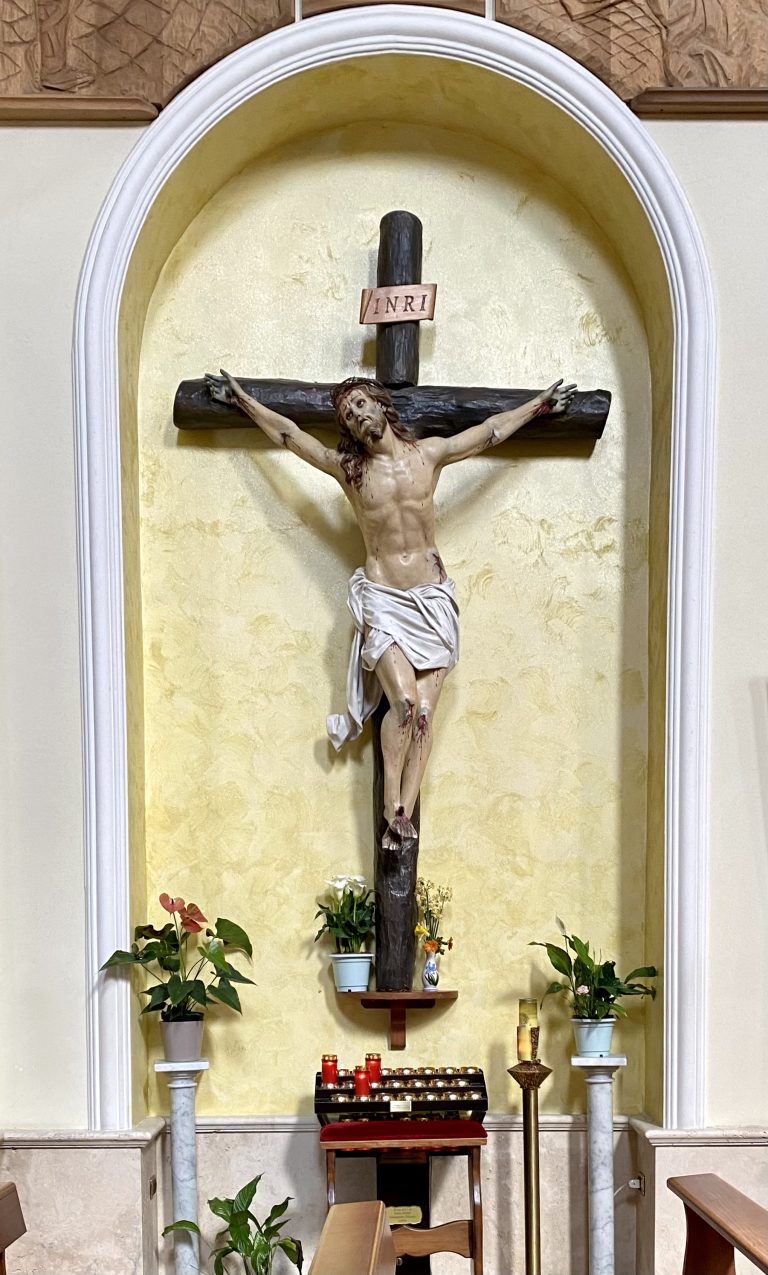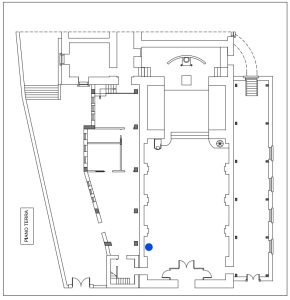Crocifisso



Parrocchia Santuario Maria SS. di Carpignano
Scultura
Crocifisso
Ambito campano
Sec. XX (1921)
Cartapesta

Parish Sanctuary Maria SS. di Carpignano
Sculpture
Crucifix
Campano area
XX century (1921)
Papier mache
Il corpo del Cristo è rappresentato anatomicamente perfetto, i muscoli e i nervi sono in tensione per gli ultimi sforzi sostenuti durante la passione. L’iconografia del Crocifisso di Carpignano è alquanto inconsueta: Cristo non è raffigurato secondo le tradizionali rappresentazioni canonizzate in età medievale, i cosiddetti “Christus triumphans” o “Christus patiens”, ovvero il Cristo trionfatore sulla morte, con lo sguardo fiero, o il Cristo sofferente, quasi sopraffatto dai peccati dell’uomo, ma è rappresentato nel momento esatto in cui, un attimo prima di morire sulla Croce, rivolge lo sguardo verso l’alto e, con l’ultimo respiro, chiede il conforto e la misericordia di Dio, pronunciando le prime parole del salmo 22:
“Dio mio, Dio mio, perché mi hai abbandonato?”.
Un salmo che inizia in maniera angosciosa e desolante per sfociare, poi, nella piena fiducia nella vittoria divina.
La croce è composta da due tronchi intersecati, sempre di cartapesta, che s’incrociano dietro la testa del Cristo.
L’opera fu commissionata dal Padre Rodolfo Ciuchini O. d. M. per ricordare i venti anni della presenza mercedaria a Carpignano (1901 – 1921) e i dieci anni della sua nomina a parroco di Carpignano (1911-1921).
I vari atti della sua committenza, o semplicemente del suo acquisto, sono sufficientemente documentati nel “Registro delle spese per i restauri della Chiesa di Maria Santissima di Carpignano”, che va dal marzo 1908 al luglio 1932.
Durante l’anno 1920 il Padre Ciuchini raccolse tra i devoti della Madonna di Carpignano, locali ed emigrati, varie offerte per l’acquisto di un nuovo Crocifisso da collocare nella Chiesa al posto del vecchio che era fatiscente.
Il danaro da lui raccolto nell’agosto del 1920 fu consegnato al nuovo rettore del Convento, Padre Adolfo Rezza O. d. M., che si occupò direttamente dell’acquisto del Crocifisso.
I soldi raccolti dal Padre Ciuchini risultarono al di sopra della spesa prevista per cui Padre Rezza decise di far realizzare due nuovi altari in marmo da collocare nella restauranda chiesa di Carpignano.
Uno dei due altari doveva servire proprio per il nuovo Crocifisso. Si ignora il luogo di realizzazione del Crocifisso ma è probabile che fosse Napoli, in quanto dal “Registro delle spese”, risulta che il 20 dicembre 1920 il Padre Rezza era a Napoli per contrattare con Giuseppe Limatola i due altari. Completata l’opera nel marzo del 1921 il Crocifisso venne trasportato a Carpignano dove il 22 marzo di quell’anno fu collocato nel Santuario.
R. M.
The body of Christ is represented anatomically perfect, the muscles and the nerves are in tension from the last efforts sustained during the passion. The iconography of the Crucifix of Carpignano is quite unusual: Christ is not depicted according to the traditional canonized representations in the Middle Ages, the so-called “Christus triumphans” or “Christus patiens”, that is Christ triumphant over death, with a proud look, or the Suffering Christ, almost overwhelmed by the sins of man, but is represented at the exact moment in which, a moment before dying on the Cross, he turns his gaze upwards and, with his last breath, asks for the comfort and mercy of God, saying the first words of Psalm 22: “My God, my God, why have you forsaken me?”.
A psalm that begins in a distressing and desolating way to then lead to full confidence in divine victory.
The cross is made up of two intersected trunks, also of papier-mache, which cross behind the head of Christ.
The work was commissioned by Father Rodolfo Ciuchini O. d. M. to commemorate the twenty years of the mercedary presence in Carpignano (1901 – 1921) and the ten years of his appointment as parish priest of Carpignano (1911-1921).
The various acts of his commission, or simply of his purchase, are sufficiently documented in the “Register of expenses for the restoration of the Church of Maria Santissima di Carpignano”, which runs from March 1908 to July 1932.
During the year 1920, Father Ciuchini collected various offers for the purchase of a new Crucifix among the devotees of the Madonna di Carpignano, both locals and emigrants, to be placed in the Church in place of the old one that was dilapidated.
The money he collected in August 1920 was handed over to the new rector of the Convent, Father Adolfo Rezza O. d. M., who was directly involved in the purchase of the Crucifix.
The money collected by Father Ciuchini turned out to be above the expected expense for which Father Rezza decided to have two new marble altars built to be placed in the restoring church of Carpignano.
One of the two altars was to serve precisely for the new Crucifix. The place where the Crucifix was built is unknown but it is likely that it was Naples, as from the “expense register”, it appears that on 20 December 1920 Father Rezza was in Naples to negotiate the two altars with Giuseppe Limatola. Completed the work in March 1921, the Crucifix was transported to Carpignano where on March 22nd of that year it was placed in the Sanctuary.
R. M.
